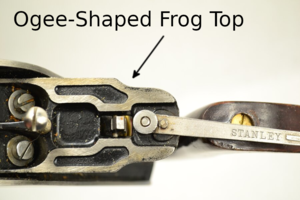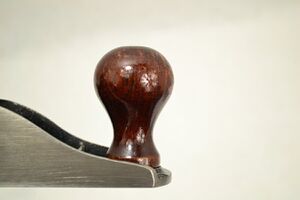Stanley Planes Type 12
Planes made by Stanley 1919-1924.
Distinguishing Features (changes from previous type in bold)
- The knob undergoes a change in height, and is now much taller than the previous style. This is referred to as a “high knob” in toolie dialect.
- The brass adjusting nut is now larger and measures 1.25″ in diameter.
- The lever cap has a subtle change in its shape – it is not as rounded about the edges as the earlier style is. The lever cam is a bit longer than the old – 1 3/16″ vs. 1 3/32″.
- A series of logo changes are found on these planes. All 3 of the logos are the result of the merger between Stanley Rule and Level, the tool producer, and The Stanley Works, the hardware producer. A notched rectangle, in which the word “STANLEY” is stamped, sits over a heart-shaped design, in which the letters “S.W.” are stamped. The “S.W.” stands for The Stanley Works, and “STANLEY”, obviously, stands for the rule and level firm. The heart-shape is a memorial to The Stanley Works long-time president, William Hart. The first version of the logo has “NEW BRITAIN,” “CONN. U.S.A.” in two lines under the heart, and dates from around 1920. The next version, dating from 1921-1922, just has “MADE IN U.S.A” below the heart, in one line that is longer than the length of the notched rectangle. The final logo, dating from 1923-1935, is identical to the second, but the “MADE IN U.S.A.” line is a hair shorter than the length of the notched rectangle. These new logos are know as the “sweetheart” logo in the tool collecting biz.
- This isn’t in the original type study – Some of the lever caps can be found with the outline of the sweetheart logo cast into the backside. I’ve only noted one of these planes, a #5, with this lever cap. Its iron is stamped with the first sweetheart trade- mark. Another tool pal of mine, from longuyland, has seen one before. These two examples are the only ones I know of in tooldom. So far, that is. [Updates to the original type study- I’ve since seen many examples with this heart shape cast in the lever cap back on several plane models including nos. 4, 5, and 5 1/2 -JC]
- Again, not found in the original type study – it’s about this time that the backs of the cap iron are no longer blued, but are just finished like the fronts, with nothing.
- Three Patent dates “Mar.-25-02” “Aug.-19-02” “APR-19-10” cast behind the frog.
- A frog adjustment screw is present. This is located below the frog, and engages a fork that is screwed to the frog. A turn of this screw will move the frog forward or backward, depending on the direction it is turned.
- The back of the lever cap is recessed.
- Flat head screws now hold the frog in place.
- The number designation, cast into the toe (“No 4”, etc.)
- The brass adjusting nut now has a left-hand thread and is now larger and measures 1.25″ in diameter.
- No patent date is found on the lateral lever.
- “BAILEY” is cast into to toe.
- The rib (the one the frog rides over) is enlarged and arched.
- The brass nuts used to secure the knob and tote to the rods have a waist to them whereas the earlier ones are cylindrical over their length.
- The rib (the one the frog rides over) is enlarged and arched.

